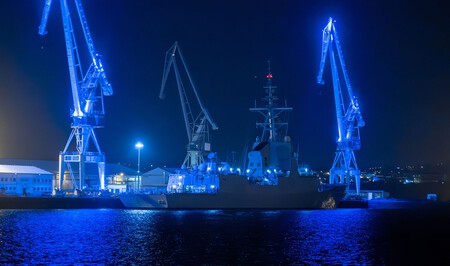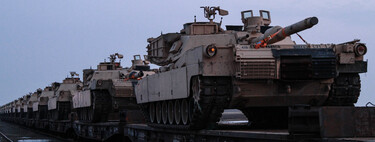Europe has entered a new era of rearmament. The Russian invasion of Ukraine reopened a arms race that seemed surpassed, and the governments of the continent have returned to look at their defense industry with urgency. In this map of reactivated factories, million-dollar contracts and multinational programs, Spain occupies an important place.
From Navantia to Indra, from ITP Aero to Escribano, the country has a network of companies that design frigates, radars, engines or intelligence systems for the most ambitious projects in Europe. This is the portrait of who is who in the Spanish defense, how much they really weigh and what role they play in the rearmament of the continent.
Opportunities and challenges in European rearmament
A study prepared by PwC for the TEDAE employers’ association offers a precise overview of the industrial weight that defense has today in Spain. According to this report, published in 2024, the Defense, Security, Aeronautics and Space industries generated 21,919 million euros of GDP (1.4% of national GDP) and 260,049 direct, indirect and induced jobs. The document does not establish a ranking, but it does make it clear that the Spanish defense ecosystem is one of the most diversified in Europe. Reading it helps to dimension the magnitude of an industrial fabric that supports a good part of European rearmament.
The momentum of the sector does not advance without friction. In an interview with El País, the president of Indra, Ángel Escribano, acknowledged that Spain still lacks a giant comparable to Rheinmetall, Thales or Leonardo. “We need a greater dimension,” he noted, adding that the objective is not to create a “national champion,” but to consolidate a fabric where companies cooperate and share capabilities. A vision that reflects both the ambitions and the internal tensions of the integration process in Spanish defense.
Industrial reactivation is not enough on its own to guarantee sustainable defense. The Elcano Royal Institute warns that the rearmament effort It cannot be measured only in investment figures or signed contracts. In one of his recent analyses, he points out that “the revitalization of Spanish defense will only be sustainable if it is based on strategic and national security criteria.” To do this, it proposes reinforcing the so-called “strategic culture”, a long-term vision that transcends industrial logic and that makes it possible to clearly define what role Spain wants to play in the European security framework.
“The revitalization of Spanish defense will only be sustainable if it is based on strategic and national security criteria”
With this warning on the table, European rearmament is also understood as an exercise of concrete capabilities. Behind every contract, every European program, there are factories, engineering and shipyards that support the modernization effort. Spain is not starting from scratch: it has a network of companies that have grown in the heat of the great projects of NATO and the European Union. Some of them are public, others private, but they are all part of the same ecosystem that is once again gaining prominence today.
The names that are defining the new defense industry in Spain
Navantia is the main reference for the Spanish naval industry and an essential piece in European rearmament. From its shipyards in Ferrol, Cartagena and Cádiz Ships have been launched for the Spanish Navy and for navies around the world, such as the F-100 frigates or the Avante corvettes. Currently, it concentrates efforts on two strategic programs: the F-110 frigates, with a contract worth 4,325 million euros, and the S-80 submarines. The F-111 “Bonifaz”, the first unit of the F-110 series, was launched on September 11, 2025 and the delivery of the first ship is scheduled for 2028. In submarines, the S-82, the second unit of the S-80 classes, was commissioned on October 3, 2025.

One of the frigates that bears the Navantia seal
But there is more. With revenues of 1,528 million euros in 2024 and more than 5,600 employees, the public company is committed to the “shipyard 4.0” model to modernize and thus respond to the growing demand for maritime capabilities from its clients.
Indra acts as the technological backbone of the Spanish defense: it integrates C4ISR systems, radars, electronic warfare and simulation, and is the national coordinator in the FCAS program for the sensor and combat cloud pillars. Its Eurofighter legacy – with avionics, defensive aids and modernizations – is complemented by sustained defense contracting. Indra closed 2024 with 4,843 million in revenue and a portfolio of 7,245 million. To this we add “combat cloud” demonstrators with the Air and Space Army.


The PW800 engine is behind the first transatlantic flight powered by 100% sustainable aviation fuel
ITP Aero is the literal and figurative engine of Spanish defense. Specialized in the design, manufacture and maintenance of turbines, it is part of the most advanced programs in Europe, from the Eurofighter to the future FCAS system, where it leads the development of the new generation engine in Spain. In 2024, it allocated 102 million euros to R&D—55% more than the previous year—and closed the year with 1,612 million in revenue. Its industrial expansion includes the Ajalvir plant, with a million-dollar investment for maintenance of GTF engines, and the reinforcement of its Zamudio center. These investments consolidate its role as a strategic propulsion supplier in NATO and the EU.
SAPA is the great Spanish specialist in armored vehicle mobility and one of the few European companies with its own capacity to develop new generation transmissions. Its technology equips the Army’s 8×8 Dragon vehicle. In addition, it has been selected by General Dynamics Land Systems to supply transmissions to US Army programs linked to the replacement of the Bradley (XM30), a long-term industrial agreement valued by the press at up to 5,000 million euros. Based in Guipúzcoa, the company works on hybrid and electric systems for military platforms, in line with trends.
Escribano Mechanical & Engineering represents the most dynamic face of the new Spanish industrial fabric. Specialized in remotely controlled weapon stations (RWS), optronics and smart ammunition, the company has managed to position itself as a key supplier of the 8×8 Dragon vehicle and the Navy. In 2024 it achieved a turnover of 355 million euros and invested 62 million in R&D, reinforcing its technological independence with the opening of a new plant in Linares. Its growth has aroused the interest of Indra, which has started an acquisition process to integrate capabilities.


VCR 8×8 Dragon Infographic
GMV is one of the big Spanish names in command, control and cyber defense systems. With 454 million euros of turnover in 2024 and an international presence that exceeds 75% of its business, the company combines civil and military capabilities in key areas such as navigation by satellite, space security and secure communications. It participates in six European Defense Fund projects, coordinating two of them —PRECISE and MYRIAD—, and maintains contracts with the European Space Agency (EUSPA) for alert and surveillance services for the Galileo system. Its dual profile makes it an essential partner for European strategic autonomy in cybersecurity and space.
Sener Aeroespacial, a subsidiary of the SENER group, combines precision engineering and industrial vision in the aerospace and defense fields. It participates in around twenty projects financed by the European Defense Fund, including the development of the HYDEF hypersonic missile system and the COMMANDS program for autonomous convoys. With 710 million euros of revenue in 2024 and more than 4,000 employees, the company maintains its headquarters in Zamudio and an international network that covers space, guidance, control and unmanned systems. Its strategy involves integrating dual capabilities—civil and military—and reinforcing its presence in the European projects that will define the defense of the future.

Tecnobit, belonging to the Oesía Group, is one of the main Spanish suppliers of avionicoptronics and secure communications systems. Headquartered in Valdepeñas and with more than 3,000 employees throughout the group, it participates in programs such as FCAS and Eurofighter, providing mission electronics, data links and simulation. In 2024, it strengthened its position in the European market with new investments in infrared sensors and artificial vision technologies.
The Spanish defense faces a decisive decade. The rise of European spending and programs offers an opportunity for unprecedented growth, but also the obligation to coordinate a still fragmented ecosystem. As some experts point out, European technological autonomy will not be achieved only with investment, but with a strategy that combines sovereignty, innovation and industrial efficiency.
Images | Navantia | TESS Defense | ITP Aero
In WorldOfSoftware | The US no longer has to worry about Spain or the rearmament bill in Europe. Germany had a plan B









